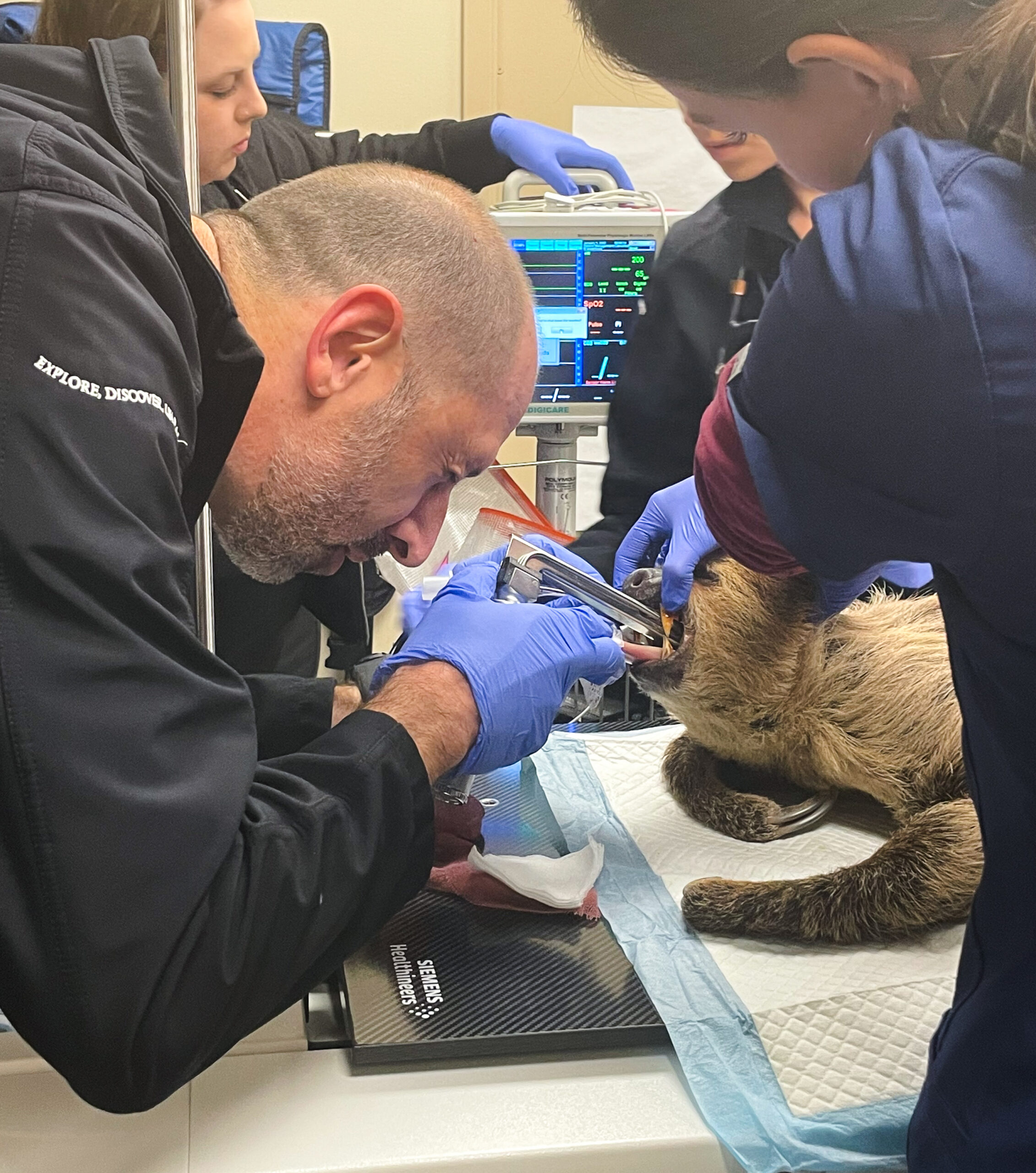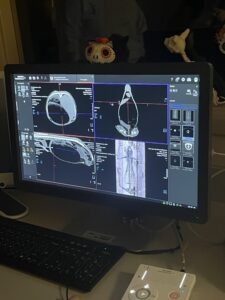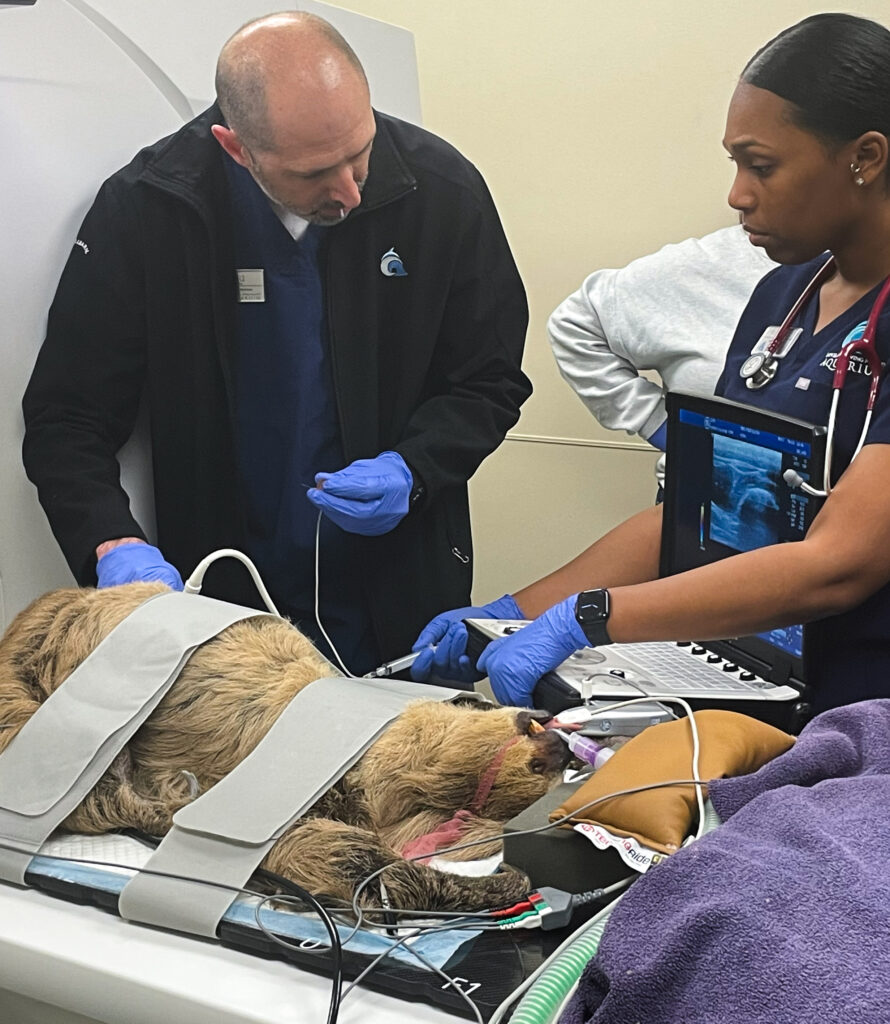Come behind-the-scenes for a look at what it takes to give a sloth a CT scan.
Wednesday, January 31, 2024 written by Ashley Garcia
On October 5, our veterinary team escorted our Linnaeus’ two-toed sloth, Takoda, to MedVet Salt Lake City for a computerized tomography Scan (a CT). The event was unprecedented for both MedVet and the Living Planet Aquarium.
Takoda is a fan favorite among Aquarium visitors since his arrival in Fall of 2017. He is described by his keepers as clever, adorable, and stubborn, but perfect in every way. So, when he started exhibiting signs that something might be wrong, our veterinary staff immediately sprang into action and was able to formulate a treatment plan with the generous help of the MedVet Salt Lake City team.

The decision to bring Takoda to MedVet Salt Lake City for a CT scan underwent much consideration to determine if this was the best course of action for diagnostics. Aquarium Veterinarian, Dr. Ari Fustukjian, said: “Takoda has some minor but chronic issues that we’ve been working on for a while. One is occasional nasal discharge, and one is increased gastrointestinal motility. Neither are major concerns in and of themselves, but we wanted to rule out as much as we could.” At the Aquarium, we have two different imaging modalities: radiographs or x-rays, which are great for looking at bones but not for soft tissue, and ultrasound, which is great for looking at soft tissue but has trouble with gas. The gas is a challenge, as sloths’ gastrointestinal tracts are full of gas all the time (this is normal for sloths.) We needed to get a very fine, detailed look at Takoda’s entire body in a way that our in-house capabilities could not match. Dr. Ari, along with our Husbandry staff, determined a CT scan was the best course of action to rule out any major concerns about GI disease and give us some insight into his chronic sinus issue so we can make a plan for additional diagnostics. So, the official preparation began!
The first step is making the transportation and procedure as stress-free as possible, which is actually something our Husbandry staff includes in a training program long before an animal needs veterinary attention. All of the animals at the Living Planet Aquarium participate in voluntary training sessions. Similar to the way you might train your dog, commands are given to the animals, and if the right behavior is performed, a reward will be given. Although, unlike your dog, commands for these animals could be “target,” “grab,” “hold,” and “touch” rather than “sit,” “stay,” or “come.” Part of this training also includes behaviors that would make medical procedures less stressful on the animal, like if the sloth needed a CT scan. Lesley, Takoda’s primary keeper, has been working on “crate training” since 2019 with the goal of getting Takoda to voluntarily go into his crate on his own instead of having to force him in. In 2021, Lesley began working with Takoda on the behavior “poke,” which is meant to train him for procedures like blood draws or vaccinations. Takoda was a fast learner and mastered these cues.
So, on the morning of October 5, our team packed up and headed to MedVet Salt Lake City. In attendance were Living Planet Aquarium Veterinarian Dr. Ari Fustukjian, Veterinary Technician Jen Edgel, Takoda’s primary keeper, Lesley Scoville, and Curator of Mammals and Birds, Becka Westover. The team was greeted by the MedVet Salt Lake City team, including Dr. Liz Lee, a boarded specialist in internal medicine who has helped the Aquarium on similar cases in the past.
This is where Lesley and Takoda’s hard work paid off. At MedVet Salt Lake City, Takoda was still able to respond to training cues calmly. These behaviors were exercised beautifully during transportation and the procedure on Takoda. Despite occurring outside his normal hours, he calmly entered his crate in the morning, and upon arrival at MedVet, he participated in a voluntary injection behavior, allowing himself to be sedated with the minimum amount of stress possible.

While he was under anesthesia, his vitals were monitored constantly. His blood oxygen level, blood pressure, heart rate, and even temperature were clearly visible in the event a change to his level of anesthesia was needed to ensure his safety. The CT scan itself went smoothly, and thanks to MedVet Salt Lake City, the Aquarium’s veterinary team got an incredibly in-depth look at all of Takoda’s anatomic structures. Takoda recovered smoothly from his procedure and was back home at the Aquarium just a short time later.
The event was considered a great success, combining top-notch animal care and voluntary behavioral participation with cutting-edge veterinary imaging technology. While the entire process was only a few hours long and appeared quite straightforward, it was only possible due to years of hard work on the part of his caretakers, along with a great deal of logistical and technical support from the veterinary specialists at MedVet Salt Lake City. The important information obtained from Takoda’s CT will be instrumental in helping the Aquarium’s veterinary team make informed decisions about his long-term care.
This was the first time the Aquarium had brought an animal directly to MedVet Salt Lake City, but it is not the first time they’ve provided support and is certainly not the last. Not only were we able to provide Takoda with the best care possible, but it was also an incredible learning opportunity for both Aquarium staff and the MedVet Salt Lake City team.


